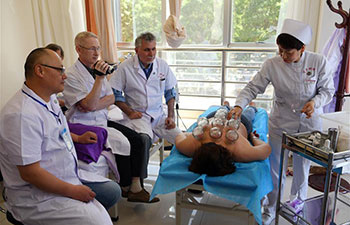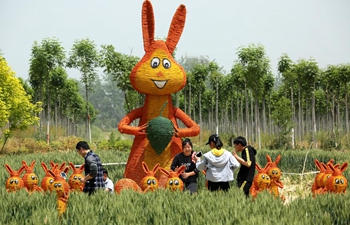SEATTLE, May 12 (Xinhua) -- A new study from Oregon State University (OSU) indicates that the family dog could serve as a partner in efforts to help children with disabilities incorporate more physical activity into their daily lives.
Researchers found in a case study published in the journal Animals of one 10-year-old boy with cerebral palsy and his family's dog that the intervention led to a wide range of improvements for the child, including physical activity as well as motor skills, quality of life and human-animal interactions.
Before starting the intervention, the researchers took initial assessments of the child's daily physical activity, motor skills and quality of life, and designed a program where the family dog would serve as a partner; a veterinarian examined the dog's fitness for participation and assessed the human-animal interaction between the dog, a year-old Pomeranian, and the child.
As children with physical disabilities such as cerebral palsy spend significantly less time participating in physical activity compared to their peers and are considered a health disparity group, meaning they generally face more health concerns than their peers, the family dog is a good choice for this type of intervention because the animal is already known to the child and there is an existing relationship, said Megan MacDonald, an assistant professor in OSU's College of Public Health and Human Sciences and corresponding author on the study.
Then the pair began the eight-week intervention, which included a supervised physical activity program once a week for 60 minutes and participation in activities such as brushing the dog with each hand; playing fetch and alternating hands; balancing on a wobble board; and marching on a balancing disc.
"The dog would also balance on the wobble board, so it became a challenge for the child -- if the dog can do it, I can, too," MacDonald was quoted as saying in a news release this week. "It was so cool to see the relationship between the child and the dog evolve over time. They develop a partnership and the activities become more fun and challenging for the child. It becomes, in part, about the dog and the responsibility of taking care of it."
The child wore an accelerometer to measure physical activity levels at home.
At the conclusion of the intervention, the researchers re-assessed and found that the child's quality of life had increased significantly in several areas, as assessed by the child as well as the parent. In addition, the child's sedentary behavior decreased and time spent on moderate to vigorous activity increased dramatically.
Also as one of the first to evaluate how a dog's behavior and wellbeing are affected by their participation in animal-assisted therapy, the study shows that the relationship between the dog and the child improved over the course of the therapy.

















